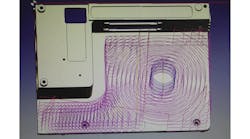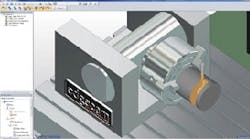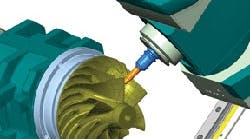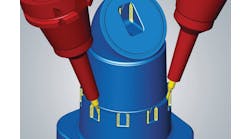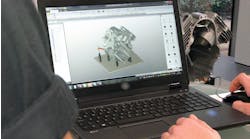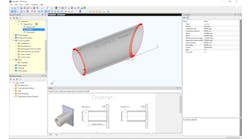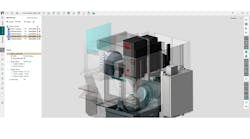According to an engineering subcontractor, the new ‘Waveform’ roughing strategy in Edgecam CNC software is pushing the boundaries of traditional milling. Chris Bentley, managing director of Mach One Engineering, reported: “It’s exciting when new technology comes along that changes things so much for the better.
“We find it a very powerfultool because it enables us to do much deeper depth cuts than before,” he continued, “and because we can also increase feed and speed rates it reduces our cycle times considerably.”
Mach One Engineering, at Aylesbury in Buckinghamshire, England, specializes at manufacturing precision engineered components and assemblies. It uses CNC milling and turning to produce parts supplied to medical equipment builders, and manufacturers of systems for defense systems, image processing, satellite communications, and electronic manufacturing services. It also offers specialty anodizing services.
Edgecam is a CAM program developed by the Vero Software Group that combines sophisticated toolpath generation with seamless CAD integration, thereby offering a complete solution for milling, turning and mill-turn programming.
Edgecam’s Waveform roughing strategy was designed to maximize material removal rates while prolonging both tool and machine tool life. It produces rough milling toolpaths that deliver shorter cycle times, greater tool life, and better surface finish, and are “kinder” to machine tools the developer said. Waveform creates its toolpaths so that when viewed from above the distance between the roughing passes (also known as the ‘stepover’) varies, but this variation allows the actual width of cut to stay the same and at the optimal level, meaning the spikes are removed. Chip load stays constant, and the depth of cut employs the cutter’s entire flute length.
For Mach One, it is proving to be an invaluable technique as it machines components for its largest customer class: satellite communications. Chris Bentley highlighted how the Waveform reduced the cycle time from two hours five minutes, to one hour 36 minutes, for an aluminum 4G broadcast amplifier casing.
Increasing the feed rate
“We went from a 4-mm depth cut to 15 mm using a 25-mm indexable insert cutter, and we reduced the stepover from 50% down to 20%. We’d expect even better results from using solid carbide, because it would give us more flute length. But, we can push the indexable insert cutter particularly hard, and we ended up moving from 2.4 meters/min. to 4.5 meters/min. – just under double the feed rate.”
Other satellite communications equipment that the ISO 9001-accredited company now manufactures with Waveform includes a component that houses electronics for a HD television broadcasting unit. “Traditionally, we roughed the open pockets with a 16-mm cutter making 6-mm depth cuts at a feed rate of 1,800 mm a minute. With Waveform we were able to take a 29-mm depth cut with a stepover of 20%.”
Although Mach One did not increase the feed rate too much for that particular job – taking it to 2.5 min/min — the feed rate for another component has more than doubled. An aluminum casing for a person-to-person communication unit is produced with a feed rate of 5.4 min/min, up from 2 min/min. Prior to deploying Waveform, the 8-mm ripper created a depth cut of 4 mm. Now, that has been increased to a 12-mm depth cut using the same tool, with a 20% stepover.
As many of Edgecam’s Waveform roughing parameters are outside the traditional machining comfort zone, Mach One’s skilled machinists were unsure, originally, that the process would work without damaging the tools.
Greater depth of cut
“In some cases we’ve increased the depth cut five times from the depth we used to have. And, even though we were reducing from a 50% stepover to 20%, the confidence just was not there at first to start pushing the feed rate higher as well. But, I’ve put some radical programs in place, and they’ve all worked,” Chris Bentley indicated. “Your instincts as a skilled miller tell you combining these depths of cut with the amount of stepover and increased feed and speed rates is going to go badly wrong. But it doesn’t. Waveform is real, it does work, and is actually pushing the boundaries of traditional milling.”
“The quicker cycle times are increasing our capacity. Quality and service is always our Number One priority,and Edgecam’s Waveform Roughing Strategy will definitely make a major contribution towards that.”
Having used Edgecam for five years, Chris Bentley said it is an integral part of Mach One’s manufacturing process now, driving three XYZ mills, a Cincinnati Arrow and Dugard Eagle. He added that since Waveform was introduced a year ago, his shop has shown a number of customers how their jobs run with the program. “Their normal reaction is ‘Wow,’ with a big smile.”
The 3,500-square foot operation also benefits from an unexpected side-effect of Waveform roughing: “It’s noticeably quieter. Everyone likes it because the machines don’t squeal, making it a more comfortable working environment for the machine operators.”
Edgecam general manager Raf Lobato said Mach One’s experiences of Waveform are typical. “It’s all about gaining the confidence to accept a whole new way of thinking,” he observed. “Because it’s going outside the normal boundaries of what has been achievable and realistic in the past, customers are doing Waveform roughing with normal feeds and speeds to begin with; and then they start to realize its enormous potential; and then they ramp up the speed and feed rates. And, as Chris says, that plays a major role in increasing profitability.”
